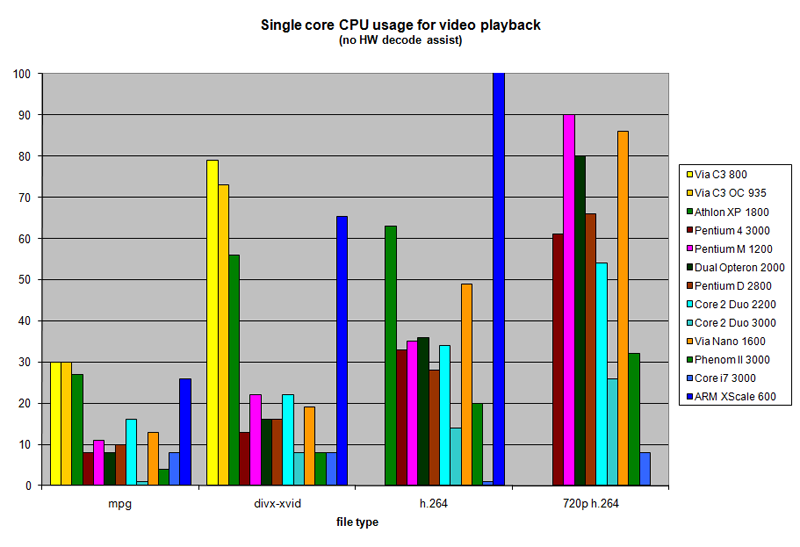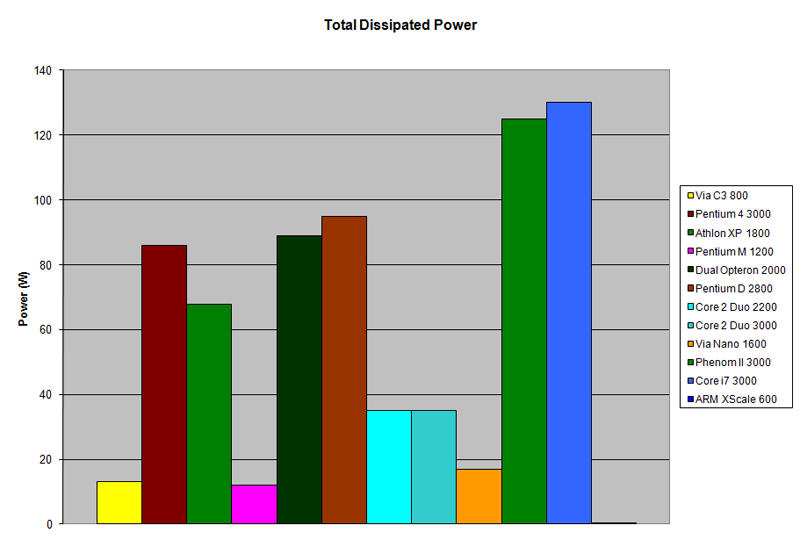2010 Video Playback Benchmark |
This is an older, rather basic benchmark I did when I was shopping for a Theater PC for my livingroom. To me, video playback is a pure pass/fail question. At the time, 1080p video was still nearly unheard of for downloads. As I lacked a test case, my tests only went up to 720p. My desire was for a quiet or silent machine. Heat from a computer must be removed. As the heat generated goes up, it becomes increasingly difficult to remove quietly. I therefore wanted a low-power system. Since hardware decoding was still flaky or low quality, I was testing software decoding only. Of course, a discrete video card would also add a great deal of heat, making silent operation even harder. Testing was done using MediaPlayerClassic-HomeCinema using the best output mode for each platform. All systems are running XP-32 except the Athlon XP (Win7-32), the Core i7 (XP-64), and the ARM XScale (Windows Mobile 5)
The Players
Via C3 (Cyrix) - 0.8GHz
Via C3 (Cyrix) Overclock - 0.94GHz
Athlon XP 2200+ - 1.8GHz
Pentium 4 - 3.0GHz
Pentium M ULV - 1.2GHz
Dual Opteron 246 - 2.0GHz
Pentium D - 2.8GHz
Core 2 Duo - 2.2GHz
Core 2 Duo - 3.0GHz
Via Nano - 1.6GHz
Phenom II x4 940 - 3.0GHz
Core i7 quad 940 - 2.93GHz
ARM XScale 0.6GHz |
 |
The test shows that all systems were capable of standard def DivX playback. While this is unsurprising in most cases, the ARM is a very nice surprise. Standard def h.264 begins to break the low end. At 720p we start seeing the limit of some of our platforms. The Pentium M and Via Nano are at their limit, which is unsurprising. More interesting, the low-end Core 2 is also above 50%. Since 1080p is twice the pixels of 720p, I could reasonably extrapolate that nothing ranked above 40-50% at 720p would handle 1080p.
The oddball is the Athlon XP. This is probably from not having proper video drivers in Windows 7. |
 |
| Since my goal was a silent computer, I also listed power requirements. Here is a chart of the max power or each CPU acording to the data sheets. I was able to confirm few of them. Also, it is worth remembering that this does not include the chipset. For instance, the chipset for the Pentium M was the same as the original release of the Atom, pulling more than the CPU. Again, the ARM is impressive. For the Power of a single Core i7, we could build a machine with over 80 XScale CPUs. Of course, price and complexity would explode, but it is an interesting point. |

